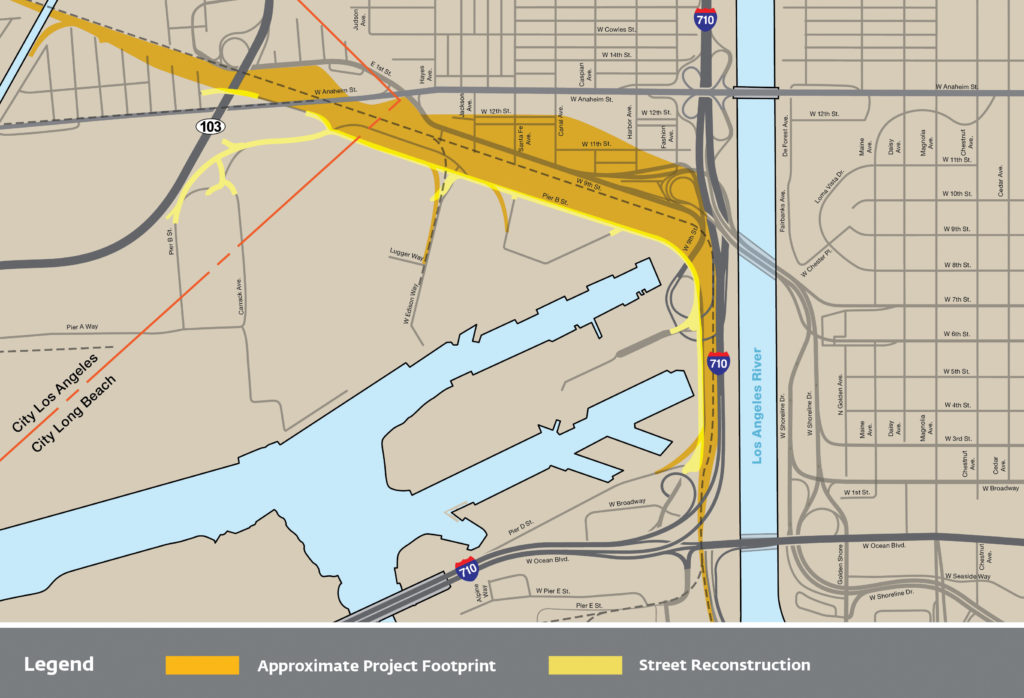Just west of the 710 Freeway, where industrial warehouses push up against Long Beach’s busy port, plans for an $870 million project are beginning to take shape. The Pier B On-Dock Rail Support Facility will expand the San Pedro Bay ports’ ocean-to-rail capabilities, another step in a collaborative effort to lower emissions from diesel drayage trucks.
“Every long train we send in and out of here eliminates about 750 truck trips off the freeways. We think that’s a very good and worthwhile activity,” Port of Long Beach Capital Program Executive Duane Kenagy told the Business Journal. “Rail is one of the most efficient means of moving goods from an emissions standpoint, and [helps reduce] traffic congestion as well.”
Since spring of last year, things have been quiet around the planned mega project, but a recent land swap between the ports of Long Beach and Los Angeles has been viewed as a sign of progress by port officials and businesses located within the project’s footprint. “I was glad to see that they’ve done some property swapping and have had some positive interactions with the City of Los Angeles, because that’s always been a concern: how will they get along?” property owner Lee Wilson said.

Wilson’s family has owned one of the properties in the project’s path since 1965. In 2009, he received a notice of preparation, a document describing the Port of Long Beach’s plans for the project, which would require him to sell his property to make space for the planned rail yard. “We’re right in the middle of the project. They’ll take the property,” Wilson said, dryly summing up the situation. “We would like to keep it forever, but we’re not against progress. And our family has been aligned with the port for over 100 years.”
The grandson of a drawbridge operator, Wilson said he recognized the value the port has brought to his family and their land. “The property and the business that’s in that building, for the last 60 years, have been totally dependent on the port,” he said. The parcel is currently home to LAN Logistics, a logistics company specializing in large and military cargo. “The property is not worth very much without the port,” Wilson added.
Because of his family’s history of collaboration and symbiosis with the port, Wilson said he supports the plan, even if it means losing his property. “If I had to criticize anything, I would have to criticize the time that it’s taken,” he said. The long gestation period of the project has presented a challenge, especially for his tenant, Wilson explained. “How do I manage a business, not knowing whether I’m still going to be in business a year from now?” he asked.
Since the port’s plans were initially announced ten years ago, local businesses and property owners have been on tenterhooks, unsure when exactly they’ll be asked to relocate. Some are frustrated by a lack of updates on the progress of the project.
“Since they’ve received approval from the city council, there’s been little to no communication from the port about what’s going on,” Stan Janocha, chief operating officer of Superior Electrical Advertising, said. “So we really don’t know what’s going on.” While his company wouldn’t be required to relocate to make space for the rail yard, Janocha said the massive project going up just a few feet from its offices might force it to.
The Long Beach City Council approved the necessary environmental impact report (EIR) for the Pier B rail facility in January 2018. The $870 million budget for the project was approved in September of that year. In March of this year, the port closed the Ninth Street Railroad Crossing in preparation of the project’s construction phase.
The recently approved land swap, in which the ports of Long Beach and Los Angeles exchanged properties that were previously owned jointly by both ports, marks the next step in the project’s long road to completion. Those properties were originally acquired in the 1990s, when the ports bought them from Southern Pacific Transportation Company and Union Pacific Railroad. They were the sites of auxiliary rail routes made obsolete by the ports’ joint purchase of the main railroad that now forms the Alameda Corridor.
“It’s comforting to see that the city and the port are making that happen,” Wilson said. “At least we’re seeing the light at the end of the tunnel of this process.” The port expects the new rail yard to be completed in 2032, according to a press release. Until construction starts, Wilson and his tenant, LAN Logistics, are working to mitigate the impacts on their future operations.
“We’re standing firm by each other’s side and working with the port to get the outcome we need,” LAN President John Donaldson told the Business Journal in an e-mail. He hopes his company can be relocated within the overweight corridor, given its focus on heavy cargo.
An agreement between the cities of Long Beach and Los Angeles to support property acquisitions within each city’s limits, as well as the land swap between ports, pave the way for the Pier B On-Dock Rail Facility project to move forward. Both were approved by the city council on November 5.
“We’re now embarking on the engineering and eventually the construction and acquisition of property,” Kenagy said. “Both ports are looking at areas of cooperation and this effort has certainly been a very positive experience of both ports working together to address a fairly complicated real estate transaction,” he added. “That’s obviously very good for the future of the San Pedro Bay.”
